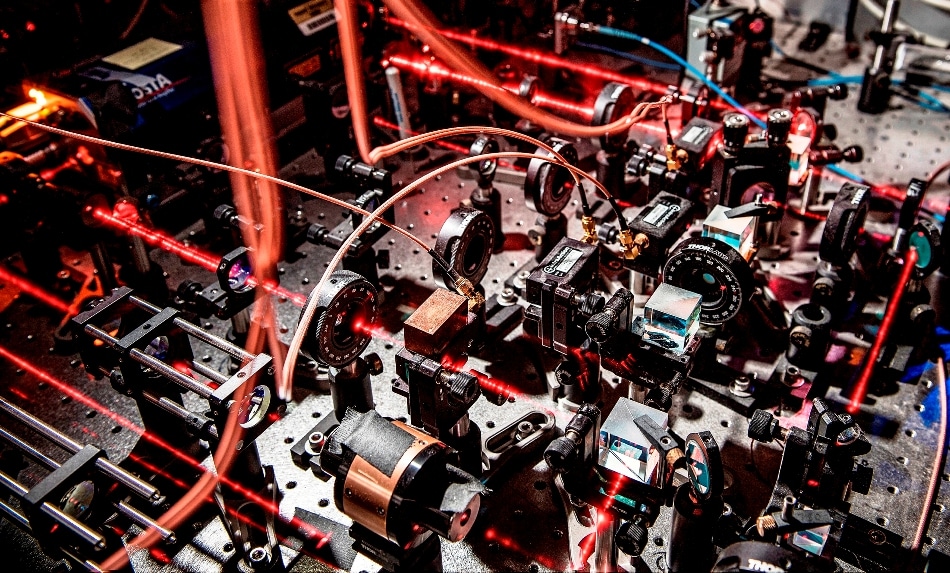Jan 30 2019
Scientists have formed an innovative testing ground for quantum systems, where specific particle interactions can be virtually turned on and off, prospectively opening the door for advancements in spintronics.
 Purdue University researchers used lasers to trap and cool atoms down to nearly absolute zero, at which point they become a quantum fluid known as Bose-Einstein condensate, and collided condensates with opposite spins. (Image credit: Purdue University photo/Purdue Quantum Center)
Purdue University researchers used lasers to trap and cool atoms down to nearly absolute zero, at which point they become a quantum fluid known as Bose-Einstein condensate, and collided condensates with opposite spins. (Image credit: Purdue University photo/Purdue Quantum Center)
Spin transport electronics can potentially transform electronic devices as they are known, specifically with regards to computing. In contrast to standard electronics in which the charge of an electron is used to encode information, spintronic devices are dependent on another inherent property of the electron—its spin.
When compared to traditional electronics, spintronics could be more reliable and faster since these devices consume less power. But the field is in its youth and there are several questions to be addressed by the researchers to enhance their control of spin information. One of the most complicated questions troubling the field is the way the signal carried by particles with spin, called spin current, decays with time.
The signal we need to make spintronics work, and to study these things, can decay. Just like we want good cell phone service to make a call, we want this signal to be strong. When spin current decays, we lose the signal.
Chuan-Hsun Li, Graduate Student in Electrical and Computer Engineering, Purdue University
In the real world, electrons do not occur independent of everything surrounding them and act the same way how they are expected to behave. Apart from interacting with other particles, they also interact among different properties within themselves. Spin-orbit coupling is the interaction of the spin of a particle (an intrinsic property) with momentum (an extrinsic property).
A new paper published in Nature Communications has reported that spin-orbit coupling and interactions with other particles can drastically improve the spin current decay in a quantum fluid known as Bose-Einstein condensate (BEC).
“People want to manipulate spin formation so we can use it to encode information, and one way to do this is to use physical mechanisms like spin-orbit coupling,” stated Li. “However, this can lead to some drawbacks, such as the loss of spin information.”
The experiment was performed in the lab of Yong Chen, a professor of physics and astronomy, and electrical and computer engineering at Purdue. At Purdue, his team developed something similar to a mini particle collider for BECs. Lasers were used for trapping Rubidium-87 atoms within a vacuum chamber and they were subsequently cooled to nearly absolute zero. (Physics junkies may recall that in 1997, laser cooling technologies won the Nobel Prize in physics. In 2018, laser trapping won the Nobel Prize in physics.)
At this stage, the atoms turn into a BEC—the most strange and coldest of the five states of matter. When they get colder, the atoms start to exhibit wave-like properties. They face an identity crisis in this quantum state; they overlap on each other and stop acting as individuals. Despite the fact that BEC is technically not a gas, this could be the simplest way to visualize it—physicists have informally named it as quantum gas or quantum fluid.
Chen and his colleagues sent two BECs with opposing spins into the mini quantum fluid collider, where the BECs smashed into one another. Similar to the behavior of two clouds of gas, they partially penetrate one another, delivering a spin current.
A lot of fascinating phenomena occur when you collide two condensates. Originally, they’re superfluid, but when they collide, part of the friction can turn them to thermal gas. Because we can control every parameter, this is a really efficient system to study these kinds of collisions.
Yong Chen, Professor of Physics and Astronomy, and Electrical and Computer engineering, Purdue University
Researchers can use this system to literally turn spin-orbit coupling on and off, which enables them to sequester its impact on spin current decay. It is not possible to do this with electrons in solid-state materials, which is partially why this system so robust, stated Chen.
The purported quantum gas is the purest system that humans can ever make. Since it lacks any disorder, it is feasible to generate a pure spin current and investigate its properties. Chen intends to continuously use this experimental testing ground and their bosonic spin current to further investigate several fundamental questions in spin transport and quantum dynamics.
One important challenge for spintronics and other related quantum technologies is to reduce decay so we can propagate spin information over longer distances, for longer times. With this new knowledge of the role of spin-orbit coupling, this may help people gain new insights to reduce spin decay and potentially also design better spintronic devices.
Yong Chen, Professor of Physics and Astronomy, and Electrical and Computer engineering, Purdue University
This study was supported by Purdue University, the Purdue Research Foundation, the National Science Foundation, the U.S. Department of Energy, Department of Defense, and Hong Kong Research Council.